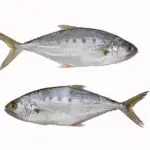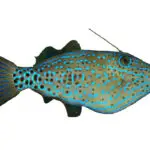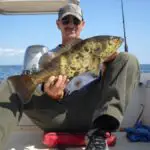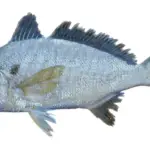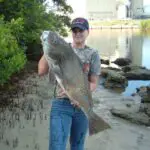The legendary Florida mullet run…
What is this fabled time of year? When is it coming to your area? And how do you fish it?
Don’t worry…I’ve been fishing the Mullet run along Florida’s east coast for 25 years and I will tell you everything you need to know!
This post may contain affiliate links. As an Amazon Associate, I earn from qualifying purchases
Table of Contents
- What Exactly Is The Mullet Run?
- When Is the Mullet Run In Florida?
- How Long Does The Florida Mullet Run Last?
- How To Track The Mullet Run
- How To Fish The Mullet Run
- Best Lures For The Mullet Run
- Final Thoughts
- Related Posts
What Exactly Is The Mullet Run?
The mullet run is an annual spawning migration of mullet along coastal beaches, inlets, and rivers. Scientists theorize that the annual mullet run is triggered by a combination of decreasing water temperatures and a change in barometric pressure.
If you are a fisherman or fan of marine biology this is a fantastic time of year!

Mullet of all sizes, from finger mullet to full-size adults migrate up and down the coast (usually heading south) as they weave in and out of protected inlets and bays offshore to spawn.
This giant migration of marine life triggers a feeding frenzy and is one of the most exciting times of the year for saltwater fishing.
When Is the Mullet Run In Florida?
The Florida mullet run begins in September, peaks in mid-October, and tapers off by December.
In Florida, the migration of mullet during the mullet run does not have an official start and end date.
Instead, it’s a time of year when large schools of mullet, up to 3 acres in size begin their spawning migrations.
Each location in the state may experience a different ‘peak‘ mullet run, and some areas may experience a stronger mullet run than others.
For example, in the Jacksonville area, anglers usually report pods of mullet as early as August since it’s the farthest north.
In central Florida along the Indian River Lagoon, the mullet run peaks in late September.
When Is The Mullet Run In South Florida?
South Florida is usually the last region to experience the mullet run as the fish migrate south. By October and November, mullets are plentiful along the beaches of Broward, Palm Beach, Monroe, and Miami-Dade county.
Is There A Spring Mullet Run?
Although it is not a spawning migration, spring is another time of year where mullet congregate and migrate along coastal waterways, especially in south Florida.
In March, April, and May, mullet are plentiful in the Florida Keys, Florida Bay, and the Everglades.
This is a great time of year to go fishing, especially for nearshore species such as sailfish, kingfish, mahi-mahi, tarpon, and sharks.
Sebastian Inlet Mullet Run
The Sebastian Inlet is world-famous for its exciting saltwater fishing, and the fall mullet run in September and October is one of the best times of year to catch snook, redfish, jack crevalle, and tarpon.
This narrow and treachours waterway is like a washing machine and funnels huge schools of mullet through its rocky shoreline.
Without a doubt, if you want to see the Sebastian inlet at its peak, go during the mullet run in September or October!
How Long Does The Florida Mullet Run Last?
The spawning migration and giant biomass of fish during the mullet run typically lasts 1-2 months, with a two-week peak in any given location in the state of Florida.

The mullet are constantly on the move, following their instinctual migration route offshore to spawn, and running away from anglers throwing cast nets and hungry predators.
How To Track The Mullet Run
The best way to track the mullet run in Florida is to talk to other anglers and boaters. Call around to local bait shops, and ask if the mullet run has arrived in their area.
By process of elimination, you can usually determine a northern range and southern range of the mullet, and narrow down a ‘peak’ window when they’ll arrive near you.
Commercial fishermen, charter captains, and fishing guides all keep a close eye on the mullet run and are usually more than willing to share some information.
And remember, just because the mullet run hasn’t arrived yet, or it’s already passed…that does not mean there are no mullet left around.
In fact, the period before and after the mullet run can also be fantastic fishing, as many juvenile and adult mullet seek refuge in creeks, flats, and protected bays after returning from offshore spawning.
How To Fish The Mullet Run
Find The Big Pods
During the mullet run, mullet will congregate and swim together in huge schools…I mean really huge schools sometimes an acre in size!
Finding these big pods of mullet is like a jackpot because the predatory fish are not going to be far.
During the annual mullet run predatory fish like tarpon, sharks, kingfish, snook and redfish will follow the big pods of mullet.
It’s not uncommon for boats with tall center console towers or surf fishermen to check multiple locations for the big schools of mullet.
Be sure to wear polarized sunglasses, and if possible position yourself with the sun at your back. Keep an eye out for diving birds, also feasting on mullet.
Find the big pods of mullet, and you will find gamefish nearby.
My preferred live bait rig during the mullet run is a 40 lb fluorocarbon leader with a 5/0 circle hook. No weight, no cork- just freelined!
Keep your bail open, and allow your mullet to swim freely. Chances are it will stay on top and it won’t be long before it gets smashed!
Fish The Edges
Once you locate a big school of mullet, try your best not to spook them. That means turning off the big motor, and using electricity or even paddling if possible.
Hang out on the edge of the school, or position your vessel so that the school will come within casting distance.
Live mullet is the best bait to use during the mullet run, for the obvious reason- that is what everything is trying to eat!
Cast your mullet on the edge of the school…you want it to stand out, not get lost in a sea of fish.
Big gamefish will look for isolated mullet, or injured mullet and bite with veracity so be ready!
Best Lures For The Mullet Run
The best lures to use during the mullet run are hard-bait or stick bait variety lures that resemble a mullet.
Anything that mimicks the size, shape, and color of mullet will work well. My personal favorites are:
- DOA Swimming Mullet
- Heddon Superspook
- Rapala X-Rap
- Mirrolure Poppa Mullet
- Yo-Zuri Hydro Pencil (amazing for snook!)
- Rebel Windcheater
During the mullet run it’s very common to see schools of mullet pushed to the surface, as they are evading predators.
For that reason, anything with a topwater or walk-the-dog action is going to work really well.
Loud, noisy, lures that churn, pop, and create a splash are what the mullet run is all about!
Final Thoughts
The mullet run in Florida is legendary…and if you haven’t experienced it before, well you are in luck.
After the dog days of summer, the mullet run breathes life back into Florida’s coastal waterways, and everything that swims wants in on the action.
Find the bait…and find the gamefish. Talk with fellow anglers to keep an eye on where the action is, and fish those edges.
Use loud topwater lures, and get ready for some of the best beach and coastal fishing of the year!
You May Also Like: Can You Catch Mullet On A Hook & Line? Yes, With These Tips!

Growing up in Florida, I’ve been surrounded by saltwater my entire life…and I love sharing my passion with others.
To learn more about why I started Saltwater Mecca, visit the ABOUT page.
Thank you for reading this article. Browse around & have some fun!

